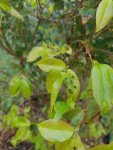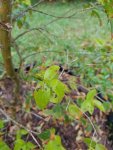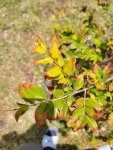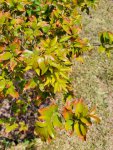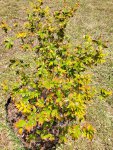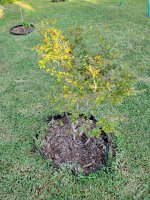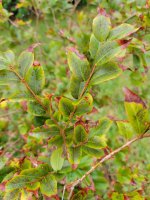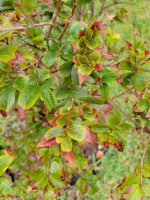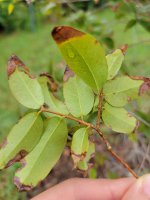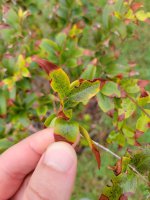I have a young jaboticaba tree in south Florida. I just planted it a few months ago and it's now putting out its first set of new leaves. I noticed on some of the new leaves there are holes in them. I tried looking all over the leaves and can't find any bugs that might be eating them. Any idea what it can be and if it's a problem? Thanks
You are using an out of date browser. It may not display this or other websites correctly.
You should upgrade or use an alternative browser.
You should upgrade or use an alternative browser.
Something eating jaboticaba leaves?
- Thread starter Cptcatz
- Start date
- Joined
- Feb 2, 2014
- Messages
- 11,484
- Reaction score
- 5,590
- Location
- La Porte Texas
- Hardiness Zone
- 8b
- Country

Looks like beetle damage, probably from cucumber beetles. There has been an outbreak of them all over the southern US. Usually they attack a plant and move on which apparently is what happened here. Just keep an eye on your tree and if they show up again spray them with a spinosad based product.
So I'm now having an issue with the leaves burning at the tips. It's pretty widespread and even showing up on the very new leaves. Any idea what the problem might be? I've been watering it every few days with tap water (barely been getting any rain over the past few months). Since I assume my water is on the alkaline side, I put soil acidifier on it on May 8, and last fertilized it with a 10-10-10 slow release on February 7. Any ideas? Thanks
Attachments
- Joined
- Feb 2, 2014
- Messages
- 11,484
- Reaction score
- 5,590
- Location
- La Porte Texas
- Hardiness Zone
- 8b
- Country

It looks a lot like two things are happening. One is a lack of water. They should never dry out and the soil should stay slightly moist. And second it appears to be suffering from iron chlorosis. This should be addressed with Chelated Iron. When you water, water very very slowly for an extended period of time. Soak the ground thoroughly. The browning started quite awhile ago, probably before you started watering. These trees grow in many types of soils, including alkaline.So I'm now having an issue with the leaves burning at the tips. It's pretty widespread and even showing up on the very new leaves. Any idea what the problem might be? I've been watering it every few days with tap water (barely been getting any rain over the past few months). Since I assume my water is on the alkaline side, I put soil acidifier on it on May 8, and last fertilized it with a 10-10-10 slow release on February 7. Any ideas? Thanks
Last edited:
So I'm still having trouble with the burnt tips. The new leaves are coming out burnt right away. I don't think it's a lack of water since I've been watering it almost daily throughout the summer. I haven't tried the iron chelate, does it still look like an iron problem?

Now that this shrub is established you shouldn't water it every day. Try watering it once a week at most, and only if there has been no rain. Soil pH and nutrient availability may also be playing a role. Fertilize occasionally with an acidifying fertilizer. Are your soils saline or exposed to salt air? This could be a factor which is hard to remedy other than planting in a raised bed or large container.
Jaboticaba (Plinia cauliflora), in the Myrtle Family (Myrtaceae), is an evergreen tree from southeastern Brazil. It is grown for its sweet , dark, grape-like, berries, which are produced from flowers that grow on the trunk and main branches (cauliflory).
Jaboticaba (Plinia cauliflora), in the Myrtle Family (Myrtaceae), is an evergreen tree from southeastern Brazil. It is grown for its sweet , dark, grape-like, berries, which are produced from flowers that grow on the trunk and main branches (cauliflory).
- Joined
- Feb 2, 2014
- Messages
- 11,484
- Reaction score
- 5,590
- Location
- La Porte Texas
- Hardiness Zone
- 8b
- Country

Being in South Florida is your soil mostly sand? If so, a lack of water is still a major concern. Do you water the entire root zone out to the drip line or just around the base of the tree? Overwatering will cause the leaf margins to brown as well as the tips. The yellowing of the leaves is caused by a nutrient deficiency, either nitrogen and/or iron. Do the chelated iron and fertilize lightly but regularly with an organic fertilizer such as Fox Farm or Espoma. Cover the ground around the base of the tree out to the drip line with a good compost such as Black Kow. Synthetic fertilizers in sandy soils will leach out very quickly while organic fertilizers actually bond to the soil and are active much longer.So I'm still having trouble with the burnt tips. The new leaves are coming out burnt right away. I don't think it's a lack of water since I've been watering it almost daily throughout the summer. I haven't tried the iron chelate, does it still look like an iron problem?View attachment 85866
I live about 5 miles inland from the ocean in southeast Florida, not sure how else to know how salty the air or soil is. I've been keeping a schedule of my fertilization. I fertilize with a cup or so of 10-10-10 synthetic mix. I have Espoma organic soil acidifier. Here's the schedule:
Fertilizer: Feb 7
Acidifier: May 8
Acidifier: June 5
Fertilizer: July 11
Acidifier: Sep 19
Fertilizer: Oct 23
Fertilizer: Feb 7
Acidifier: May 8
Acidifier: June 5
Fertilizer: July 11
Acidifier: Sep 19
Fertilizer: Oct 23
Now would be a good time to get a professional soil test.
It would eliminate some of the guesswork and let you know what state your soil is in. Often suggested remedies are given with the analyses. If you do go this route, please do post your results. I know I'd be curious to see what was discovered.
It would eliminate some of the guesswork and let you know what state your soil is in. Often suggested remedies are given with the analyses. If you do go this route, please do post your results. I know I'd be curious to see what was discovered.
Yeah the soil is all sand, very fast draining. The surface is a black loamy sand but underneath is basically tan beach sand, doesn't look too nutritious. I have a basic cheap mulch around the dripline of the tree which is what I water. I'll try the iron chelate and compost next time I go to Home Depot.Being in South Florida is your soil mostly sand? If so, a lack of water is still a major concern. Do you water the entire root zone out to the drip line or just around the base of the tree? Overwatering will cause the leaf margins to brown as well as the tips. The yellowing of the leaves is caused by a nutrient deficiency, either nitrogen and/or iron. Do the chelated iron and fertilize lightly but regularly with an organic fertilizer such as Fox Farm or Espoma. Cover the ground around the base of the tree out to the drip line with a good compost such as Black Kow. Synthetic fertilizers in sandy soils will leach out very quickly while organic fertilizers actually bond to the soil and are active much longer.
Attachments
Thanks I'll look into the professional testNow would be a good time to get a professional soil test.
It would eliminate some of the guesswork and let you know what state your soil is in. Often suggested remedies are given with the analyses. If you do go this route, please do post your results. I know I'd be curious to see what was discovered.
- Joined
- Feb 2, 2014
- Messages
- 11,484
- Reaction score
- 5,590
- Location
- La Porte Texas
- Hardiness Zone
- 8b
- Country

It is possible that the blackening of the leaves is a fungus but it really looks more like sooty mold which is caused by the excrement of mainly aphids, mites or thrips insects. Your tree is in a stressed state which invites harmful insects. Get a magnifying glass and look closely on the bottom of the leaves for very tiny insects and when you find any of them spray with a spinosad based insecticide or fresh Neem Oil. Spinosad is safe for people and pets. If you are completely positive that there are no insects spray with a copper based fungicide such as Bonide Liquid Copper or Neem Oil. Liquid Copper is a better fungicide than Neem. Also Neem Oil has a short shelf life, even when unopened.So I just went out and noticed a brand new problem. Nearly every leaf has these black spots showing up. Anyone know what this might be from?
I just looked closer... there are no pests under the leaves and the black spots are not sooty, it doesn't rub off, it's inside the leaf material. See pics.It is possible that the blackening of the leaves is a fungus but it really looks more like sooty mold which is caused by the excrement of mainly aphids, mites or thrips insects. Your tree is in a stressed state which invites harmful insects. Get a magnifying glass and look closely on the bottom of the leaves for very tiny insects and when you find any of them spray with a spinosad based insecticide or fresh Neem Oil. Spinosad is safe for people and pets. If you are completely positive that there are no insects spray with a copper based fungicide such as Bonide Liquid Copper or Neem Oil. Liquid Copper is a better fungicide than Neem. Also Neem Oil has a short shelf life, even when unopened.
I've been reading that jaboticaba thrives in pots and now I'm regretting putting it into the ground in the first place. It's been in the ground for exactly a year now... is it possible to transplant it back into a pot?
Attachments
Those spots could be a fungal leaf-spot disease, but they might just be another aspect of nutritional deficiencies and cultural stress.
Yes, you might be able to dig up the plant's rootball and re-pot it in a large container. There is always some risk when transplanting an woody plant that is established in the ground. Ironically, this might be less of a risk for you since the plant has never become fully established. Nevertheless try to dig up as large a rootball as is necessary to cause minimal root damage. If you do need to prune the roots to get into a container do so in a thoughtful and controlled manner. Transplant in to a container of 15 gallons or larger.
Yes, you might be able to dig up the plant's rootball and re-pot it in a large container. There is always some risk when transplanting an woody plant that is established in the ground. Ironically, this might be less of a risk for you since the plant has never become fully established. Nevertheless try to dig up as large a rootball as is necessary to cause minimal root damage. If you do need to prune the roots to get into a container do so in a thoughtful and controlled manner. Transplant in to a container of 15 gallons or larger.
Ask a Question
Want to reply to this thread or ask your own question?
You'll need to choose a username for the site, which only take a couple of moments. After that, you can post your question and our members will help you out.
Similar Threads
Forum statistics
Latest Threads
-
Help my red Robin tree
- Started by will352
-
Cutting the plastic from a grafted scion?
- Started by gdgross
-
Kill or Keep: Lady bug vs Squash Beetle
- Started by gunslingor
-
New apple/pear seedlings leaf disease
- Started by chiefcommander
-
Warts?
- Started by Nethacott
-
I Might Have Messed Up Again
- Started by big rockpile
-
The Japanese Turnip
- Started by Meadowlark
-
Growing melons and winter squash vertically, netting.
- Started by YumYum
-
Suggestion For Covered Pergola Outdoor Kitchen?
- Started by Ambrose A. Dale

